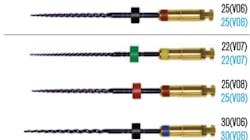Being a general dentist means being a jack-of-all-trades, master of “a few.” As such, general dentists are not necessarily introduced to, or knowledgeable about, the plethora of instrumentation available when performing specialty procedures. I would surmise that many of us have been using the same materials and instruments that we were introduced to in dental school to provide those specialty procedures to our patients. While those products may have a long track record of success, sometimes they have their limitations. Root canal therapy is a specialty procedure that is no exception to that assumption.
Rotary files being the standard of care in today’s endodontic procedures has led to widespread innovation in materials and instrumentation. There are dozens of well-known file systems on the market that can lead to excellent clinical results. But which system is the best? My endodontist friends seem to have a common saying among them: “The best file system is the one that works best in your hands and leads to predictable outcomes.” I previously had no specific loyalty to any single rotary file system for root canals. And if you ask your endodontist friends, they often keep two or three different systems in their offices. Typically, though, they have a singular file system as their workhorse, and they use it to complete most of their cases.
Also by the author:
- Better orthodontic impressions with the putty + wash method
- Note to young dentists: In-person dental meetings still matter
Along the way, I have found my own workhorse rotary file system is SS White’s DCTaperH system (figure 1). Beyond providing predictable and excellent results, I have found that my stress level when using this system is much lower, because I worry less about file separation and calcified canal cases. I use this system in conjunction with SS White’s EndoGuide access and troughing burs (figure 2) so I can tackle regular and tougher cases with the same predictability and outcome.
The EndoGuide bur series is a variation of SS White’s highly successful Fissurotomy burs, which are used in conservative enamel removal in pit and fissure caries. This conservation of tooth structure is mirrored in the EndoGuide burs as they allow for accurate access to the pulp chamber, especially useful in the anterior teeth. Additionally, the burs can be used to trough for hidden canals with the tip “dropping” into a hidden canal. The robust design of these burs allows me to quickly and efficiently open the canal orifice without worrying about separation of the bur.
Once a tooth has been accessed with the EndoGuide burs, I typically am able to jump to rotary files much quicker than when using other rotary systems. This is because the DCTaperH system has a few unique characteristics that nudge it ahead of some of the competition.
First, the metallurgy of the nickel-titanium (NiTi) files in conjunction with the specific heat treatment of the files help them hold memory and make them less susceptible to stress fatigue than other files. I can use the system for longer and more rotations with less worry about separation and breakage. I can also use the files in situations where a canal has a more severe curve and where cyclical fatigue is a major concern.
Second, the DCTaperH system contains a Glide Path series of three files that are used in conjunction with the traditional #8, #10, and #15 hand files. These three files are a variable tapered system with apical sizes as small as a #13 file (also a #14 and #17 apical size). This allows progression through the file sizes more quickly, even with the most highly calcified canals.
Last, the variable taper design of the system is meant to mimic that of a natural canal but maintains a smaller diameter throughout the file. Overinstrumentation and the possibility of a strip perforation are less likely to occur, especially with smaller teeth with dilacerations. I can conserve more of the tooth and theoretically leave more natural tooth structure to support future restorations and function.
Along the way, I have found that SS White’s EndoGuide and DCTaperH systems are what work in my hands. I tend to gravitate toward these systems because they allow me to provide the best clinical outcomes for my patients. For anyone worried about stepping too far away from their own favorite file systems, SS White has comparable files to other well-known file systems but with their proprietary metallurgy and heat treatment. You’ll be able to use their systems with immediate familiarity and benefit from the properties unique to SS White’s files. Try SS White’s EndoGuide burs, DCTaperH file system, and/or comparable file systems. I know you will find that these products help reduce much of the stress inherent with performing such technique-sensitive procedures.
Editor's note: This article appeared in the September 2022 print edition of Dental Economics magazine. Dentists in North America are eligible for a complimentary print subscription. Sign up here.
About the Author

Neville T. Hatfield, DMD
Neville T. Hatfield, DMD, graduated magna cum laude from the Boston University School of Dentistry. He completed a general practice residency at the Manhattan Veteran Affairs Hospital, where he provided interspecialty comprehensive prosthetic and surgical treatment to medically complex patients. When he is not treating patients in northern New Jersey, he enjoys lecturing about dental materials and products.
Updated April 7, 2023


